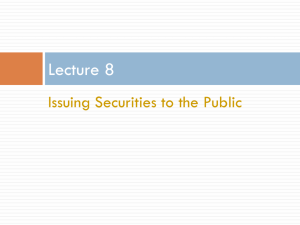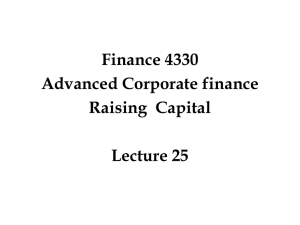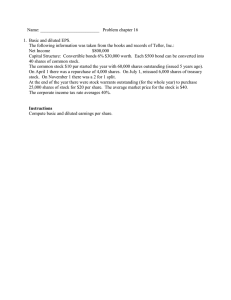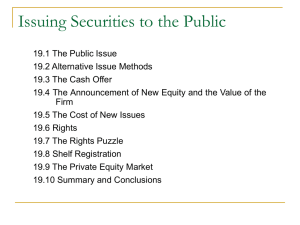Raising Capital: Venture Capital, IPOs, and Equity Issues
advertisement
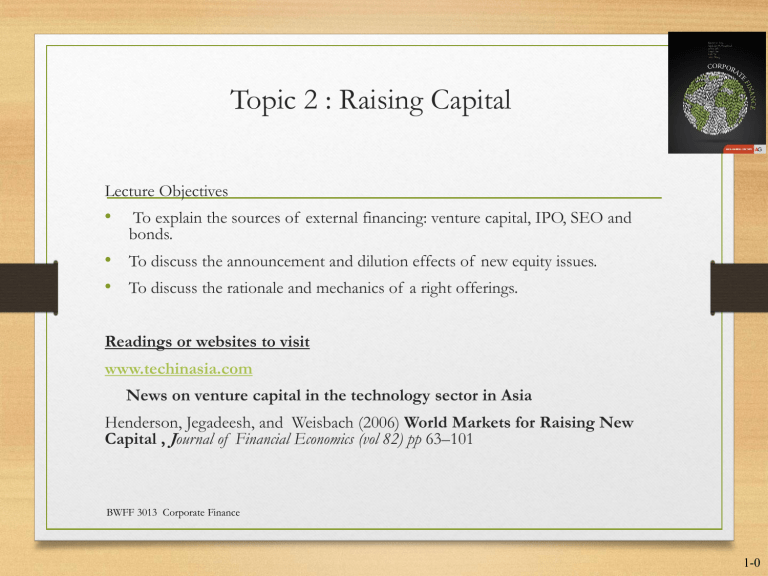
Topic 2 : Raising Capital Lecture Objectives • To explain the sources of external financing: venture capital, IPO, SEO and bonds. • To discuss the announcement and dilution effects of new equity issues. • To discuss the rationale and mechanics of a right offerings. Readings or websites to visit www.techinasia.com News on venture capital in the technology sector in Asia Henderson, Jegadeesh, and Weisbach (2006) World Markets for Raising New Capital , Journal of Financial Economics (vol 82) pp 63–101 BWFF 3013 Corporate Finance 1-0 20.1 20.2 20.3 20.4 20.5 20.6 20.7 20.8 20.9 20.10 20.11 Chapter Outline Early-Stage Financing: Venture Capital &Crowdfunding The Public Issue Alternative Issue Methods The Cash Offer The Announcement of New Equity and the Value of the Firm The Cost of New Issues Rights The Rights Puzzle Dilution Shelf Registration Issuing Long-Term Debt 1-1 Venture Capitalists (VCs) • Financial intermediaries that are typically set up as limited partnerships • Play an active role in overseeing, advising, and monitoring companies in which they invest • Generally do not want to own the investment forever 1-2 Crowdfunding • Alternative method of raising equity finance. • Entrepreneur or business can attract “crowd” of investors. • Each of whom takes a small stake by contributing towards an online fundraising target. • Eg of crowdfunding organization in Malaysia are Pitch Platform Sdn Bhd and Alix Global Sdn Bhd https://www.tutor2u.net/business/reference/crowdfunding BWFF 3013 Corporate Finance 1-3 Stages of Financing 1. 2. 3. 4. 5. 6. Seed-Money Stage Start-Up First-Round Financing Second-Round Financing Third-Round Financing Fourth-Round Financing 1-4 20.2 The Public Issue • The Basic Procedure In The U.S. • Management gets the approval of the Board. • The firm prepares and files a registration statement with the SEC. • The SEC studies the registration statement during the waiting period. • The firm prepares and files an amended registration statement with the SEC. • If everything is satisfactory with the SEC, a price is set and a full-fledged selling effort gets underway. 1-5 The Process of a Public Offering Steps in Public Offering Time Several months 1. Pre-underwriting conferences 20-day waiting period 2. Registration statements Usually on the 20th day 3. Pricing the issue After the 20th day 4. Public offering and sale 30 days after offering 5. Market stabilization 1-6 An Example of a Tombstone 1-7 20.3 Alternative Issue Methods • There are two kinds of public issues: • The general cash offer • The rights offer • Almost all debt is sold in general cash offerings. 1-8 Table 20.1 - I 1-9 Table 20.1 - II 1-10 20.4 The Cash Offer • There are three methods for issuing securities for cash: • Firm Commitment • Best Efforts • Dutch Auction • There are two methods for selecting an underwriter • Competitive • Negotiated 1-11 Firm Commitment Underwriting • The issuing firm sells the entire issue to the underwriting syndicate. • The syndicate then resells the issue to the public. • The underwriter makes money on the spread between the price paid to the issuer and the price received from investors when the stock is sold. • The syndicate bears the risk of not being able to sell the entire issue for more than the 1-12 Best Efforts Underwriting • Underwriter must make their “best effort” to sell the securities at an agreed-upon offering price. • The company bears the risk of the issue not being sold. • The offer may be pulled if there is not enough interest at the offer price. The company does not get the capital, and they have still incurred substantial flotation costs. • This type of underwriting is not as common 1-13 Dutch Auction Underwriting • Underwriter accepts a series of bids that include number of shares and price per share. • The price that everyone pays is the highest price that will result in all shares being sold. • There is an incentive to bid high to make sure you get in on the auction but knowing that you will probably pay a lower price than you bid. • The Treasury has used Dutch auctions for years. • Google was the first large Dutch auction IPO. 1-14 Investment Banks • Also called underwriters • Perform critical functions: • Help determine type of security, method of sale, and offering price • Sell the securities • Typically using a syndicate to limit risk • For compensation – the spread • Stabilize IPO prices in the aftermarket 1-15 IPO Underpricing • May be difficult to price an IPO because there is not a current market price available. • Private companies tend to have more asymmetric information than companies that are already publicly traded. • Underwriters want to ensure that, on average, their clients earn a good return on IPOs. • Underpricing causes the issuer to “leave money on the table.” 1-16 IPO Underpricing In Asia And Various Countries 1-17 20.5 The Announcement of New Equity and the Value of the Firm • The market value of existing equity drops on the announcement of a new issue of common stock. • Reasons include • Managerial Information Since the managers are the insiders, perhaps they are selling new stock because they think it is overpriced. • Debt Capacity If the market infers that the managers are issuing new equity to reduce their debt-equity ratio due to the specter of financial distress, the stock price will fall. • Issue Costs 1-18 20.6 The Cost of New Issues 1. 2. 3. 4. 5. 6. Gross spread, or underwriting discount Other direct expenses Indirect expenses Abnormal returns Underpricing Green Shoe Option 1-19 The Costs of Equity Public Offerings Proceeds Direct Costs Underpricing (in millions) SEOs IPOs IPOs 2 - 9.99 35.11% 25.22% 20.42% 10 - 19.99 13.86% 14.69% 10.33% 20 - 39.99 9.54% 14.03% 17.03% 40 - 59.99 13.96% 9.77% 28.26% 60 - 79.99 6.85% 8.94% 28.36% 80 - 99.99 6.72% 8.55% 32.92% 100 - 199.99 5.23% 7.96% 21.55% 200 - 499.99 4.94% 6.84% 6.19% 500 and up 3.37% 5.50% 6.64%` 1-20 20.7 Rights • If a preemptive right is contained in the firm’s articles of incorporation, the firm must offer any new issue of common stock first to existing shareholders. • This allows shareholders to maintain their percentage ownership if they so desire. 1-21 Mechanics of Rights Offerings • The management of the firm must decide: • The exercise price (the price existing shareholders must pay for new shares). • How many rights will be required to purchase one new share of stock. • These rights have value: • Shareholders can either exercise their rights or sell their rights. 1-22 Rights Offering Example • Popular Delusions, Inc. is proposing a rights offering. There are 200,000 shares outstanding trading at $25 each. There will be 10,000 new shares issued at a $20 subscription price. • What is the new market value of the firm? • What is the ex-rights price? • What is the value of a right? 1-23 What is the new market value of the firm? $25 $20 $5,200,000 200,000 shares 10,000 shares share shares There are 200,000 outstanding shares at $25 each. There will be 10,000 new shares issued at a $20 subscription price. 1-24 What Is the Ex-Rights Price? • There are 210,000 outstanding shares of a firm with a market value of $5,200,000. • Thus the value of an ex-rights share is: $5,200,000 = $24.7619 210,000 shares And, the value of a right is: $0.2381 = $25 – $24.7619 1-25 Alternative Way to Compute the ExRights Price and Value of a Right • 10,000 new shares will be issued for 200,000 outstanding shares, or this is a 1 for 20 rights issue • Hence we have: 20 shares @ $25 plus 1 share @ $20 = $500 = $20 equals 21 shares with value of so price of 1 share ex-rights $520 $520/21 = $24.7619 • Value of 1 right = $25 - $24.7619 = $0.2381 1-26 20.8 The Rights Puzzle • The vast majority of new issues in the U.S. are underwritten, even though rights offerings are much cheaper. • A few explanations: • Underwriters increase the stock price. There is not much evidence for this, but it sounds good. • The underwriter provides a form of insurance to the issuing firm in a firm-commitment underwriting. • Underwriters “certify” the price to the market. • The proceeds from underwriting may be available sooner than the proceeds from a rights offering. 1-27 20.9 Dilution • Dilution is a loss in value for existing shareholders: • Percentage ownership – shares sold to the general public without a rights offering • Market value – firm accepts negative NPV projects • Earnings per share – may decline even with positive NPV projects (at least in short run) • Book value– occurs when market-to-book value is less than one 1-28 20.10 Shelf Registration • Permits a corporation to register an offering that it reasonably expects to sell within the next two years. • Not all companies are allowed shelf registration. • Qualifications include: • The firm must be rated investment grade. • They cannot have recently defaulted on debt. • The market capitalization must be > $150 m. • No recent SEC violations. 1-29 20.11 Issuing Long-Term Debt • Public issuance follows the same general process as stocks • Direct financing • Term loans • Private placements • Direct financing may have more restrictive covenants and higher rates, but is less costly to issue and easier to negotiate. 1-30

